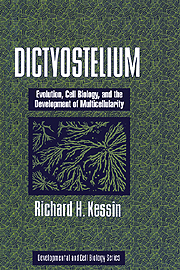Book contents
- Frontmatter
- Contents
- Preface
- 1 A Brief Introduction to Dictyostelium discoideum and its Relatives
- 2 A History of Research on Dictyostelium discoideum
- 3 The Evolutionary Biology of Dictyostelium
- 4 The Genome and Genetics
- 5 Membranes and Organelles of Dictyostelium
- 6 Cell Motility and the Cytoskeleton
- 7 The Transition from Growth to Development: From Starvation to Self-Sustaining cAMP Signal Relay
- 8 Chemotaxis and Aggregation
- 9 Differentiation and Adhesion in the Aggregate
- 10 The Behavior of Cells in the Slug
- 11 Culmination
- 12 Formation and Germination of Spores
- 13 Resources
- References
- Index
- Plate section
11 - Culmination
Published online by Cambridge University Press: 07 October 2009
- Frontmatter
- Contents
- Preface
- 1 A Brief Introduction to Dictyostelium discoideum and its Relatives
- 2 A History of Research on Dictyostelium discoideum
- 3 The Evolutionary Biology of Dictyostelium
- 4 The Genome and Genetics
- 5 Membranes and Organelles of Dictyostelium
- 6 Cell Motility and the Cytoskeleton
- 7 The Transition from Growth to Development: From Starvation to Self-Sustaining cAMP Signal Relay
- 8 Chemotaxis and Aggregation
- 9 Differentiation and Adhesion in the Aggregate
- 10 The Behavior of Cells in the Slug
- 11 Culmination
- 12 Formation and Germination of Spores
- 13 Resources
- References
- Index
- Plate section
Summary
Deciding when migration has gone on long enough
One of the decisions that a slug must make is when to form a fruiting body. It is possible to trick slugs into migrating toward light until they expire, having used all of their reserves. The slug offers the organism escape from noxious environments, dispersal, and perhaps protection from nematodes, but ultimately the major protection is the creation of a resistant spore, placed so that it can be dispersed. This transition is accomplished late in development by a series of elaborate cell maneuvers. The slug begins with a set of partially differentiated prespore cells, all contiguous in the rear of the structure, and at the end has put these cells, fully encapsulated, into a loosely held sphere at the top of a stalk.
Ammonia, as we learned in Chapter 10, causes the slugs to refrain from culmination. They migrate away from it, so it may have a negative chemotactic effect. Sussman, White, and Schindler determined that 108 cells contain about 5 mg of protein, and that during the course of development about 2 mg of this protein is degraded, eventually releasing a substantial amount of ammonia (Schindler and Sussman, 1977; White and Sussman, 1961). Similar observations were made by Gregg et al. (1954). Wilson and Rutherford (1978) measured the amounts of ammonia in tissue slices and found that it accumulated at the end of development.
- Type
- Chapter
- Information
- DictyosteliumEvolution, Cell Biology, and the Development of Multicellularity, pp. 188 - 209Publisher: Cambridge University PressPrint publication year: 2001



